#experimental archaeology
Text
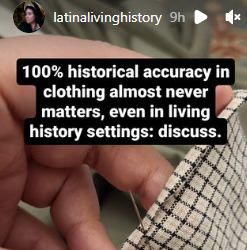
I have a lot of opinions on this but I would love to know what other people think.
#sewing#living history#historical costuming#history#historical reenactment#historical accuracy#historically accurate#historically adequate#historical sewing#museums#material culture#experimental archaeology
326 notes
·
View notes
Text
Experimental Archeologists are fucking rad!
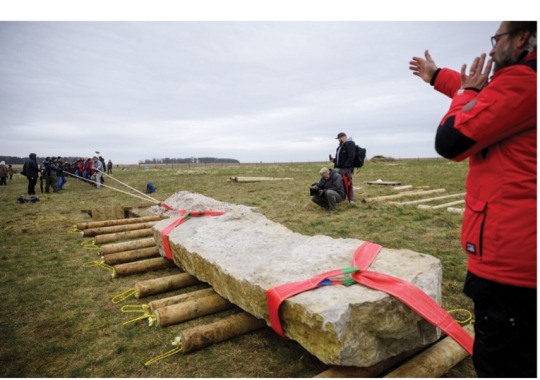
Let me geek out about science a bit more, alright? And for that I really wanna talk about that part of archeology that normal folks know very little about: Experimental Archeology.
And I know for a lot of people this sounds kinda strange. How the fuck are you going to experiment about archeology? Isn't archeology all about dicking in the dirt for some ceramic or something? Or about excavating ruins?
Well, here is the thing. Ruins and ceramics can tell us a lot about the life back in "ye olden days", but they also leave a lot of questions. Questions about how the people were actually living and how the things that were excavated were actually created.
You might know all those Ancient Alien nutjobs. Folks that will yell about how people in the ancient times (or, lets be honest, how non-white people in the ancient times) could never have ever done this with the technology of the time.
That is where experimental archeology comes in. In a lot of the cases from the old times we actually have found some tools, too. So we know what kind of tools that might have been used and the like. And as thus they experiment how to use those tools and other things we know were available to create those things.
With that we know that for example Stonehenge could have been created by very few people in a fairly short amount of time. We also have a good idea of how the pyramids might have been build and how many people it took. (Less than you think.)
But experimental archeologists and experimental historians do even more. They recreate food and the methods it was cooked based on findings we made. They recreate clothing and furniture and other tools, learning a lot about the process through it.
Which is amazing - and we are learning quite a lot about the past through it. It is fucking amazing.
179 notes
·
View notes
Text
For those who may or may not remember my mostly historically accurate Stede Bonnet lip balm, get ready-- I'm going to start experimenting soon with mostly historically accurate lavender soap.
So... I guess be prepared for me to accidentally explode more shit, hooray.
#if I don't do the pearl-powder face cream first#I've got a lot going on tbh#lotta ridiculous research#lotta#experimental archaeology#to conduct from#stede bonnet's theoretical library#our flag means death#trifles the amateur history enthusiast strikes again#funky little alchemist with funky little interests
502 notes
·
View notes
Text
Experimental archaeology is so cool.
188 notes
·
View notes
Text
Would really love a cooking show, that instead of your usual cooking show, each episode focused on a different time period and part of the world, and the episode focused on the cooking techniques and dishes of that time. The set would also be made to look accurate to that time period, and the cooks would have to use only what would have been available at that time
129 notes
·
View notes
Text
Adventures in Plant Dyeing: Part 6 - Tansy
During the spring break I decided to do some more plant dyeing, this time with tansy. Tansy is a yellow flower that was traditionally used for medicinal purposes. It's meant to yield bright yellows on its own, and olive green with iron.

I used 50g of dried tansy to dye 250g of wool fibre, which ended up not being a great idea as the dye wasn't very concentrated and all my colours were quite pale. I could have partially solved this by putting some of the skeins in first to obtain a more vibrant shade, then putting the rest after a few minutes to get a paler colour, but I was unreasonably optimistic and hoped I'd get some bright colours anyway.
I used 3 50g skeins of white pure wool, one of which was my handspun, and 1 100g skein.

I mordanted all the skeins with alum for 45 minutes while I soaked the dried tansy in hot water to extract the dye. The dyebath turned a rich, dark brown.
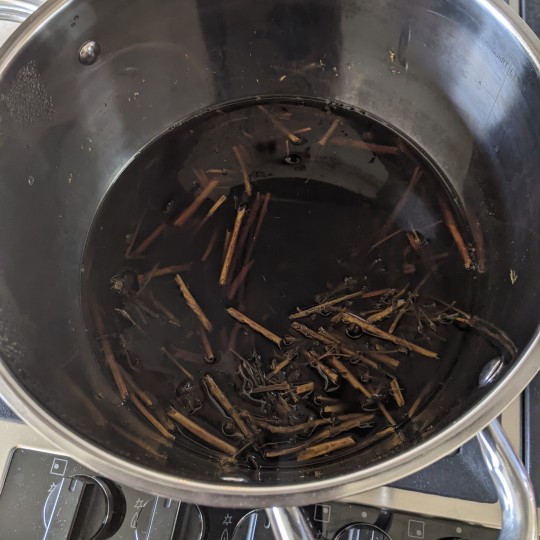
Then I strained the dye bath and split it into 2 pots, adding calcium carbonate to one. I put 3 skeins in the original bath and one in the bath with the calcium carbonate. I heated them for half an hour, making sure they didn't boil, and left them to cool for 15 minutes. The skein in the bath with the calcium carbonate turned a pretty shade of lemon yellow, while the others were a slightly more mustard colour.
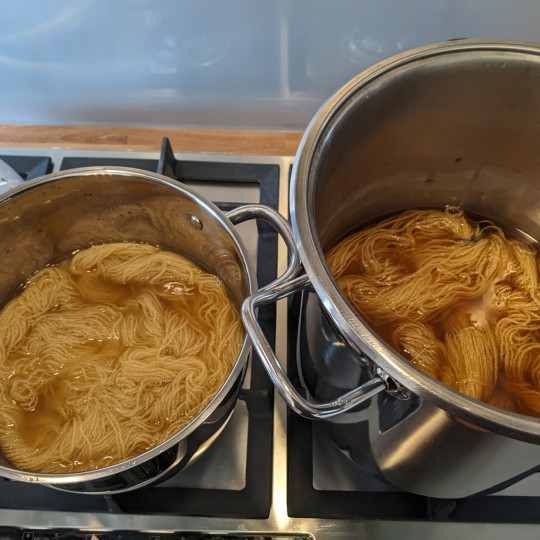
I then rinsed all the skeins before preparing one afterbath of citric acid and one of ferrous sulphate (iron), to use as colour modifiers. I did this by adding roughly a teaspoon of the modifier to a few inches of hot water, then adding the yarn and heating gently for 15 minutes until they had changed colour.
The iron did indeed turn the pale yellow into a pale green as expected, however the citric acid, which is meant to produce cooler yellows, only succeeded in lightening the already-pale yarn, leaving me with a beige yarn barely more pigmented than the white I started off with.
Here are the yarns after drying:

From left to right: Citric acid, calcium carbonate, no modifier, ferrous sulphate
On the whole I'm pretty happy with the results given how little dyestuff I used, but I would definitely try this again with a much higher dye-to-fibre ratio. I think I'll leave the beige skein in my dyeing basket to be redyed next time...
30 notes
·
View notes
Text
Hello my friends I am in the reading experimental archeology papers phase of worldbuilding
16 notes
·
View notes
Text
If yall are willing to fund me I WILL reconstruct ancient gender affirming medical treatments and I WILL test them on myself. Anesthesia will not be involved. If I must, I will even drink horse piss. Fuck it! I can do whatever I want to myself there’s no law against that!! Fund my experiments boy
8 notes
·
View notes
Text
Hearing this gives me chills. I'm sure it's only an approximation of what it sounded like back in Sumer, but still.
61 notes
·
View notes
Text
53 notes
·
View notes
Text
I don’t know that if ever actually attempt it and being this specific makes me feel like a shill for a corporation but tbh I think if you’re going to make a White Gilgamesh you gotta go extra and get one of Dogfish Head’s ancient ales like Midas Touch cuz like, they’re actually directly based on archaeological work. Idk feels like if you’re going to mix goat milk and beer you should use something theoretically closer to the kind of beer some Sumerian fuck would’ve used to do the same
37 notes
·
View notes
Text
#hello i just watched this video and started crying when they said the original sculptor's finger prints are preserved in the bronze casting#this is so cool and i love this sculpture so much#im also thinking i need to start looking into archaeology in turtle island and see if there's any Indigenous archaeologists to work with..#bc ive always wanted to do archaeology but archaeology in turtle island has such a bad past#and is very closely associated with theft and disrespectful practices for Indigenous peoples past and present#so i never really considered doing archaeology here as an option#thought the only way to do archaeology in a way that honoured and respected the people of the past would be to go abroad#but this video and the care that was taken when recreating the pots in bronze makes it clear that no#it is possible to do archaeology in a good way here too#i just have to find other Indigenous people who are the ones leading the research teams#anyway. this is a v cool video and it made me emotional so here. for you all to see as well!#indigenous#indigenous art#sculpture#experimental archaeology#archeology#video
49 notes
·
View notes
Text
Guess who's doing alchemy in the studio again!
(ME, IT'S ME)
Time for
The Wash-Balls of Neroly
Version 3.1
So anyway, where were we?
Previously on "Trifles and Their Terrible Tribulations": The soap had jellied at an early stage, but adding almond meal led to miracles.
Following all that, I was going to be so careful with the next batch. Which is why, naturally, I started it soaking back on November 29th and... promptly didn't stir or even check on it until tonight, almost an entire month later.
Figure 1. Portrait of soap mix that has decided to show Mercy.

This is, in fact, a really good consistency to end up with! No jelly in sight, and it somehow is the right consistency to tip into the mortar for the next step: a shittload of scents.
Figure 2. Two "drops" of labdanum resin-oil, and thirty-eight drops of Neroli oil, because Simon Barbe did not fuck around.

These get folded in gently (though not with that terminology), and the mix is now back to a bit of a thick, soupy consistency.
Figure 3. That's some good soup.

The directions at this point say to beat "a long time to mix it well", and this has caused me Sadness in the past when even beating for a significant period of time did not yield anything like a stiff "paste" that could be rolled into balls, requiring that I find solace in salt as an additive to get the soap to calm tf down.
Almond meal was the version 3.0 revelation (due to it being a Secret Additive, related to the preparation of "dried" labdanum).
And tonight... I shall add almond flour.
WISH ME LUCK.
#live from the workshop#SOAP#our flag means death#experimental archaeology#history#funky little alchemist with funky little interests#trifles the amateur history enthusiast strikes again#soap of neroly
59 notes
·
View notes
Text
No it's not a bow and arrow or a fire bow

#bow drill#experimental archaeology#art of bushcraft#outdoors#bushcraft#ways of survival#outdoorlife#ways of old#knowledge is the best survival gear#flint knapping#art#my art#stone tools
10 notes
·
View notes
Video
youtube
The Longbow Vs Cuir Bouilli (Boiled Leather) - Video 22
6 notes
·
View notes
Text
Adventures in Plant Dyeing: Part 3 - Madder
I recently bought 100g of chopped madder root and a small amount of ferrous sulphate to use as a dye modifier and so I decided to give it a go.
Madder is a plant whose roots contains a wonderful red pigment. It grows wild in England but is native to the Eastern Mediterranean. Ferrous sulphate is a modifier that can be used after dyeing to change the colour of the yarn. It tends to darken the colour and make it duller.


First I mordanted 3 50g skeins of white yarn using alum. Then I prepared the madder dye bath by soaking the madder roots in cold water for an hour before gradually heating it up to about 75°C. Apparently you mustn't let the madder boil because then it will only produce browns. Then I strained it and added 2 of my skeins to the dye bath. I was pleased to discover that the madder had quite a pleasant earthy, nutty smell, which was definitely better than boiling grass.
The so-called 'first dip' in the dye bath produces vibrant reds, which would have gone to the more high-status members of society. However after the first dip more fibre would be added and this would turn out a paler colour which would have been used for the poor. This would have continued until the dye bath was completely exhausted. I wanted to test this out and so kept back 1 skein to add later.
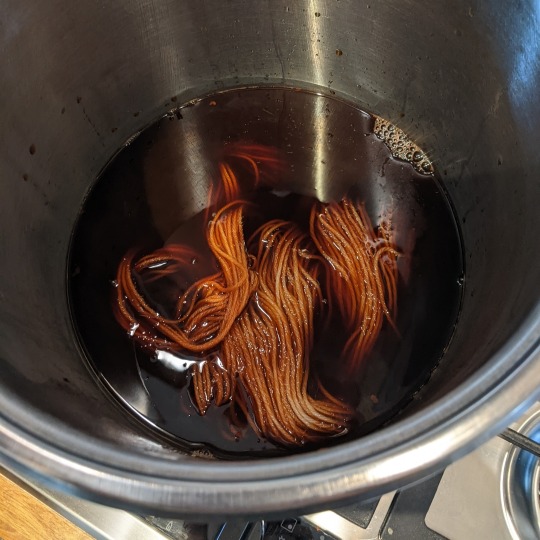
After an hour and a half, I removed the wool from the madder and rinsed it, then I added the final skein and continued to simmer it. Next I prepared the iron modifier for 1 of the skeins. I added a pinch of the ferrous sulphate (wearing gloves) to a saucepan of water and heated it until it dissolved. Then I added the yarn and left it for about half an hour, at which point I removed both the modified yarn and the second dip yarn in the madder. The modified yarn had turned an amazing dark purple, whilst the second dip yarn was a pale orange. I rinsed both out, whilst wearing gloves, and left them to dry.
Here are the results: From left to right, madder with iron modifier, 1st dip madder, 2nd dip madder.
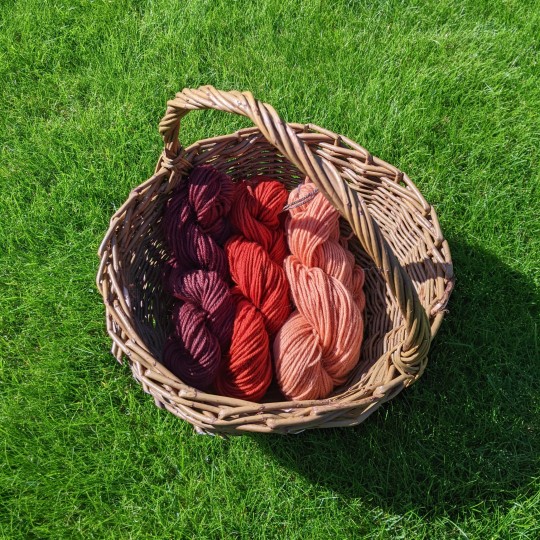
I was very surprised by how vibrant the red turned out, and how deep the iron turned the yarn just using a small pinch of iron.
I plan to dye with dried homegrown coreopsis flowers next.
#plant dyeing#living history#experimental archaeology#plant dyes#madder#reenactment#dyeing#fibre arts
94 notes
·
View notes